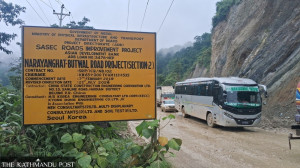Lumbini Province
Local units in Rukum East and West come together to preserve biodiversity
Sisne, Puthauttarganga and Banfikot are known to be home to red pandas and pangolins and rare medicinal herbs.
Hari Gautam
Sisne, Puthauttarganga and Banfikot local units in Rukum East and West have taken initiatives to conserve a biodiversity hotspot known for being home to rare species like red pandas and pangolins.
Officials of Sisne and Puthauttarganga Rural Municipalities of Rukum (East) and Banfikot Rural Municipality in Rukum (West) have requested the provincial and federal governments to help them in conservation efforts.
These local units share borders with each other and are rich in biodiversity. According to the Division Forest Office in Rukum (East), these areas are the main habitat of endangered red panda and pangolins among other wild animals.
According to locals, there are also various plant species in the community forests, ponds, rivers and rivulets in these areas. “The local units have started campaigns at the local level to preserve wild animals and plants. It’s a praiseworthy work,” said Samil Pun, a local of Puthauttarganga. According to him, biodiversity conservation is the best way to tackle environmental degradation.
In a recent programme organised at Rukum (East), chiefs of Puthauttarganga, Sisne and Banfikot, people representatives and the concerned stakeholders decided to conserve and maintain biodiversity. In the current fiscal year, these local units have prepared a working guideline to implement the decision.
Kumari Baral, chairperson of Sisne Rural Municipality, said that increased human activities have badly affected biodiversity. “Our life can only be sustained if we maintain the ecology of the land,” said Baral, adding that they have started awareness programmes in the settlements.
Even though red pandas can be commonly seen in Sisne and Puthauttarganga, the concerned authorities have not yet conducted a census survey to determine its population. “We can easily spot red pandas in Puthauttarganga. In the past, we used to chase red pandas from our fields. But now, through awareness programmes, we know that these are rare species and should be preserved,” said Pun.
Puthauttarganga Rural Municipality has started to preserve biodiversity by adopting scientific forest management in the community forests. This local unit has also made a working guideline to conserve the habitat of red panda and sustainable use of medicinal herbs.
On the other hand, Sisne Rural Municipality has made some policy level decisions for biodiversity conservation. According to the policy, every house in the rural municipality should plant two trees and plant trees saplings in the open areas, said Baral. Mohan Rokamagar, the headmaster of Himalaya Secondary School in Sisne, said that biodiversity should be maintained to preserve the ecosystem. “All of the animals and plant species should be preserved to maintain the ecosystem,” said Rokamagar, referring works of local units as an exemplary.
Banfikot Rural Municipality in Rukum (West) too has made a working guideline to preserve pangolins and aquatic species. This local unit is going to manage the scattered settlements into an integrated settlement and promote afforestation programmes. Dharma Bahadur KC, chairman of Banfikot Rural Municipality, said, “If we use natural resources in a haphazard manner, there will be nothing left for our future generation. We should understand this and use natural resources in a scientific way.”
Meanwhile, Besindra Raj Subedi, Division Forest Officer, said that forests are the main part of biodiversity. He said, “The ecosystem can only be maintained if forests are conserved. That’s why we will help local units for their conservation efforts.”




 16.57°C Kathmandu
16.57°C Kathmandu.jpg)














